Installing a heated towel rail in the bathroom: DIY installation guide
For a home foreman with skills in plumbing installation heated towel rail not a daunting task. Before proceeding with the installation of the device, it is necessary to determine the optimal drying model and connection method.
You should develop a frame and familiarize yourself with the installation steps. Compliance with requirements and installation technology will ensure uninterrupted operation heated towel rail.
The content of the article:
Criterias of choice heated towel rail For bathroom
The durability of plumbing equipment depends on its initial characteristics and compliance with installation technology. An important role will be played by the compliance of the selected model with the operating conditions.
At choosing a heated towel rail special attention should be paid to the operating principle, material of manufacture and configuration heated towel rail.
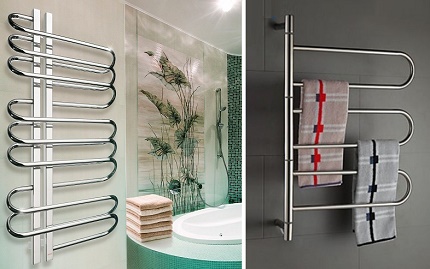
Principle of operation and technical specifications
All models of “towel dryers” for the bathroom are divided into three types:
- water;
- electric;
- combined.
Water aggregates function due to the circulation of hot coolant. Connection is made through a heating or water supply system. The main plus of such models is energy saving.
Lack of water heated towel rail - the complexity of the installation, if the device is not initially included in the communication system of the apartment or house.
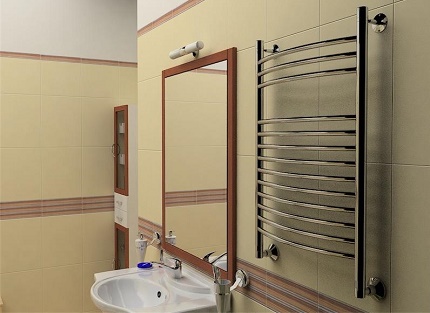
At choosing a water heated towel rail the pressure in the pipeline must be taken into account.
In modern apartment buildings system pressure DHW It is about 8-10 atmospheres, and in the buildings of the old foundation - 5-7 atmospheres. Most imported models heated towel rails differ in low working pressure, and the wall thickness of the pipe does not exceed 1.25 mm. The service life of the device in a typical high-rise building is 1-2 years.
The choice of a coil for a private house is quite extensive, since pressure in the autonomous system heating is small.
Electric heated towel rail It functions autonomously, regardless of the operation of other systems. To work, you need an uninterrupted supply of electricity.
Use of the device is advisable in the following cases:
- requires quick installation without interfering with the heating or water supply system;
- installation of "backup" heated towel rail;
- the need to place the coil outside the bathroom - a portable electric drying model is ideal.
To avoid excessive energy consumption should choose an electric heated towel rail by the volume of the room. Optimally, if per 1 square. m accounts for 140 watts of energy - under such conditions, the bath warms up to 22-24 °. If unit necessary for the spring-summer period, then low-power models are suitable at the rate of 100 watts per 1 sq. m
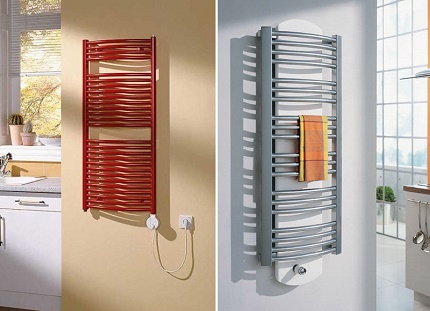
The power of “wet” models reaches 2 kW, “dry” devices - 100-200 watts.
Combined heated towel rails able to work in two modes: from the network or from the system DHW. This is the most practical and effective heating option, but the high cost of a universal coil frightens away many buyers.
Material for manufacturing a plumbing device
In the manufacture of a coil heated towel rails usually use three metals:
- stainless steel
- copper and brass;
- black steel.
Stainless steel appliances resistant to moisture, but susceptible to impurities contained in water. Over time, a precipitate forms on the walls of the coil, restricting the flow of water.
Choosing heated towel rail stainless steel, preference should be given to chrome models with a wall thickness of 2 mm or more.
Brass and copper radiators characterized by high heat dissipation, but have a limited period of use. When buying, you need to check the product passport. It should indicate that the pipes are galvanized from the inside and heated towel rail suitable for tapping into the system DHW.
Black steel moody to the coolant. Models of such material are recommended for installation in an autonomous heating system, where pressure drops are excluded. To the central system DHW connection of a coil with anticorrosive internal protection is admissible.
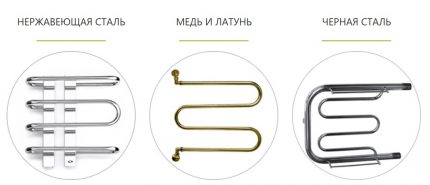
Dimensions and shape heated towel rail
Size and configuration are determined based on the location of the dryer, the dimensions of the bath and personal preferences. In addition, it is necessary to take into account the insertion method: lateral, diagonal, upper or lower.
Classic M- and U-shapes are affordable and optimally suited to replace worn-out Soviet coils. Radiators "ladder", "foxtrot" and "modern" are more spacious. The area allows you to place laundry, as in stationary drying.

Heated towel rail It should be combined with the design of the bathroom and not clutter up the space.
Connection heated towel rail: DHW or heating
Before installing a watermark heated towel rail in the bathroom, you need to determine the method of its connection.
Two options are available:
- Insertion into the system DHW. The method guarantees year-round heating. The device heats up during the consumption of hot water - per night heated towel rail cools down even when directly turned on through the riser.
- Inset to the heating system. The option is relevant in the absence of a centralized hot water supply network. Due to the forced circulation of the coolant, the coil remains warm all day. The disadvantage is the functioning of drying only in the cold season.
At towel warmer replacement in an apartment building with a change in the way it is connected, you will need to develop a project and approve it in Housing and communal services. Registration of a package of documents will take about a month.
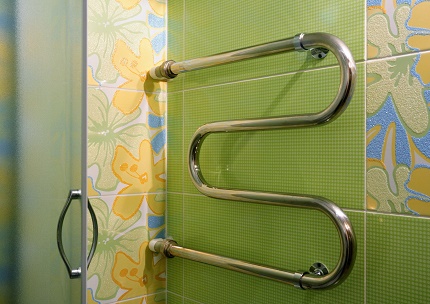
General installation requirements
Installation heated towel rail with the "water" principle of action is performed subject to a number of conditions:
№1. The diameter of the pipes of the device must correspond to the diameter of the riser, restriction from installed fittings.
№2. A jumper must be provided between the drying outlets. Bypass performs a number of tasks:
- maintaining the speed of water circulation throughout the riser;
- separation of coolant flows allows you to save heat for subsequent points of intake;
A significant plus of switching on the closing sections, bypasses, is the possibility of disconnecting heated towel rail to carry out repairs without interrupting the operation of the system as a whole.
№3. It is forbidden to install shutoff valves in the pipeline section to the bypass and directly on the jumper.
Non-compliance with the requirement entails:
- slowing down the circulation of water in the riser and a drop in the temperature of the coolant;
- pressure deterioration in apartments located in the direction of water supply.
The closing sections can be equipped with the usual ball valves on the bypass and the supply line or more functional three-way valves, which allow the coolant to be sent either to the bypass or to the radiator.
№4. The recommended height for towel drying according to SNiP is 120 cm from the floor.
№5. Maximum distances between the heater and wall cladding:
- 3.5-4 cm - if the diameter of the coil is 2.5 cm or less;
- 5-7 cm - with a pipe section of more than 2.5 cm.
If a bypass is provided in the wiring diagram, it is permissible to install shut-off valves at the output and at the input of the device ball valves.
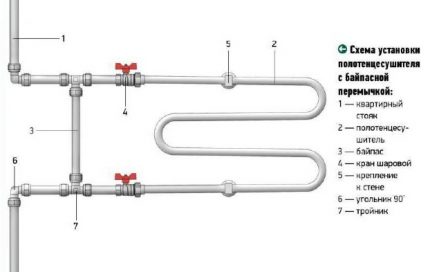
Recommended and invalid tie-ins
The performance of the coil is based on the principle of a “gravity pump”. Competent insert provides natural circulation and radiator performance. Development of a water installation scheme heated towel rail do it yourself in accordance with the design of a specific model and the location of the riser in the bathroom.
Side and diagonal connection
For most devices, the insert is considered optimal with the supply of coolant through the upper outlet and outlet from the bottom. This is achieved with universal connections, the diagrams of which are given below.
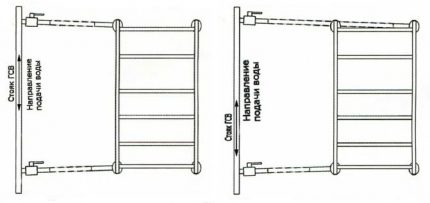
Advantages of a universal insert:
- performance does not depend on the direction and speed of the water in the riser;
- after turning off the circulation, no air bleeding is required;
The universal insert option allows you to position heated towel rail at any convenient installation distance from the riser.
Circuit functioning conditions:
- The lower insertion point is located below the radiator connection pipe, and the upper insertion, respectively, is above the upper outlet. The slope of the supply pipes is 2-3 cm per meter. Horizontal connection is acceptable for pipes with a cross section of 32 mm, as well as if the distance to the riser is less than 2 m.
- Leading pipes - without bends and “humps”. Otherwise the system airs and natural circulation ceases.
- The optimum diameter of the supply pipes: ¾ inch steel, 25 mm - polypropylene reinforced.
- It is desirable to insulate pipes. This requirement is especially relevant for the hidden installation of a plastic pipeline.
A fully functional side / diagonal tie-in circuit with a narrowed bypass. Plumbers resort to this design on a previously installed heated towel railif there is no need to completely change constructive riser.
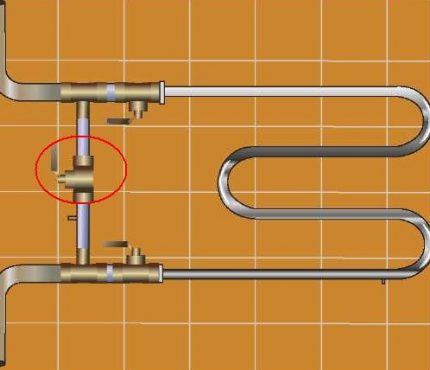
Offset bypass is justified if you want to keep the old approaches to the riser. With this connection method, it is not recommended to use a narrowed jumper. The main requirement is the upper flow of the coolant.
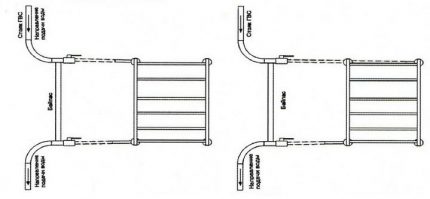
Some models of dryers are designed for lower connection.The insertion is carried out according to three main schemes.
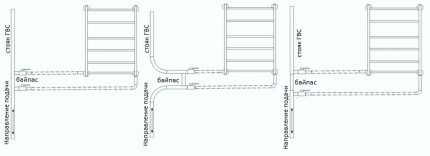
Requirements for the implementation of the lower connection:
- The lower branch must be located below heated towel rail.
- Lead pipes are preferably insulated.
- When using an offset or narrowed bypass, the upper outlet of the riser is located below the connection point to the device.
The optimum slope is about 2 cm per meter of pipe. The fulfillment of this condition ensures the independence of the circuit from the direction of the water flow.
Possible forced side options
With lateral connection, some deviations from the typical recommended schemes are permissible.
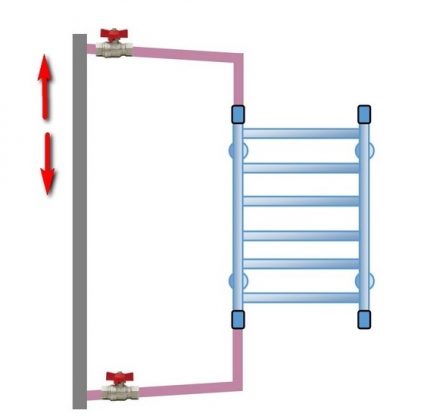
The main conditions of the insert remain unchanged. Difference in connection points heated towel rail with riser, as well as in the presence of vertical segments at the input and output of the device.
An alternative side cutout is presented below. Top heated towel rail located above the upper bend. After shutting off the water, air will need to be vented from the coil.
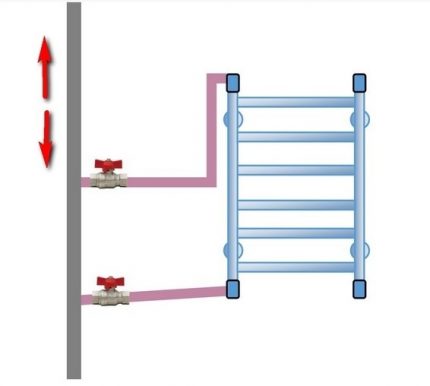
Some mutable maybe the bottom frame. The need to place pipes from the riser at a minimum distance to the floor forces to increase both ascending connections. Subject to all the requirements of the lower connection, the system works without failures.
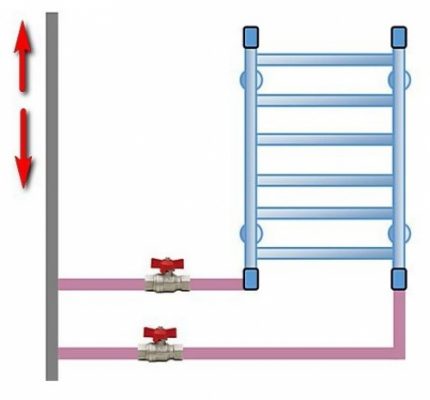
Incorrect wiring diagrams
Inexperienced masters sometimes do not adhere to the recommended schemes. As a result, the drying remains cold with uninterrupted supply of hot water. Examples of possible omissions are shown below.
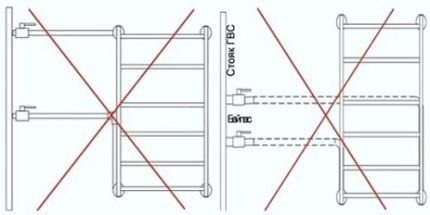
In both versions, the device is located below the lower outlet from the riser. The coolant that has descended down is cooled and trapped. Water is not pushed back, since there is a pressure of the coolant flow from above.
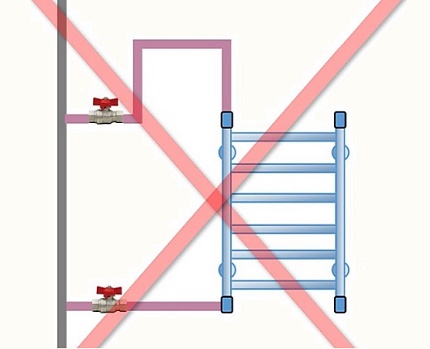
In the resulting "hump" air accumulates. Over time, the air plug blocks the circulation in the radiator and heated towel rail cools down.
The option presented below combines two errors at the same time. The scheme is obviously not working.
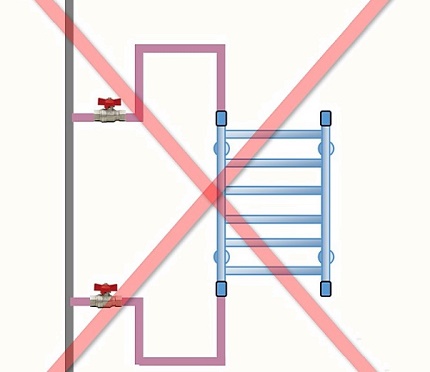
Step-by-step installation of water heated towel rail
Mounting technology heated towel rail DIY is the same for different connection schemes. The phased process includes dismantling the worn-out device, supplying pipes from the riser, installing cranes, and attaching the coil.
Preparation of tools and materials
Tool kit required for installation and replacement heated towel raildepends on the type of water pipes in the room. For installation through polypropylene pipes you will need: ball valves; mounting brackets; polypropylene pipes; soldering iron and knife for cutting PP pipes.
Standard equipment heated towel rail includes:
- transition corners;
- silicone gaskets;
- locking nodes;
- telescopic brackets;
- crane "Mayevsky».
In the system, it is desirable to use components of one metal in order to avoid the appearance of electrolytic corrosion.
Dismantling of old equipment
Before dismantling the obsolete coil, it is necessary to coordinate with housekeeping organization. Disconnecting the riser from the water requires special permission.
Following actions:
- If the towel dryer is not integral with the hot line, then the threaded connections just need to be unscrewed.
- If the device is welded to the riser, then it should be cut off with a grinder. The remainder of the pipe feed should be enough for threading.
- Remove the old device from the brackets.
The height of the riser in the riser should exceed the distance between the nozzles of the new device by the length of the couplings and bends required to insert the bypass jumper

Installation of bypass and ball valves
The coil can be mounted without installing a bypass, but experts recommend that a jumper be provided in advance. At the ends heated towel rail ball valves are installed. If necessary, it will turn out to shut off the flow of coolant to the device, while water will circulate freely along the riser.
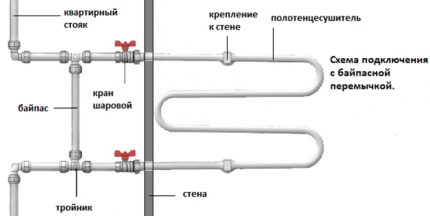
To install cranes on pipe sections, cut a new thread using a die of the desired diameter. If the thread survived after dismantling the old device, then it is enough to “drive” it with a die to improve the connection. Install stopcocks on prepared pipes.
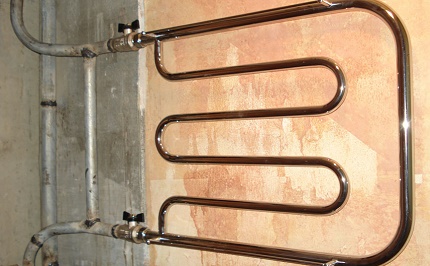
Coil Mount heated towel rail
The procedure for “hanging” and connecting the device is as follows:
- Mark the brackets on the wall - you must observe the horizontal placement of the coil.
- Prepare holes and insert dowels into them.
- Screw the brackets to heated towel rail, attach the device to the wall and fix with screws. It is important to maintain the recommended distance between the radiator and wall facing.
- Connect the unit to the valves on the jumper with fittingsconnections to tighten linen winding.
Depending on the type of connection, straight or angled threaded fitting.
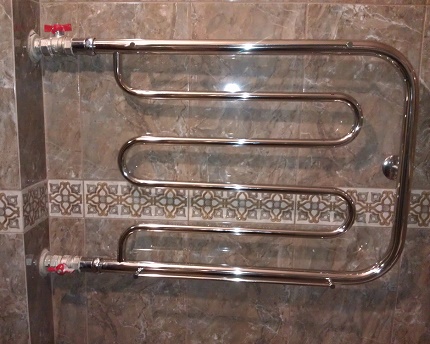
Features of the installation of electrical models
Unlike water models, electric dryers can be installed anywhere, as they are independent of the location of the heating pipes and hot water supply. In this case, special attention should be paid to the quality of the wiring.
Requirements to electrical installation heated towel rails:
- The installation location is selected taking into account the level of protection of the device from moisture. The distance to the bathroom or washbasin is at least 60 cm.
- The minimum distance to the floor is 20 cm, to the wall - 30 cm, to the surface of furniture - 75 cm.
- The heating device must not be placed directly under the outlet.
Electrical connection is carried out in accordance with the international standard NFC-15-100.
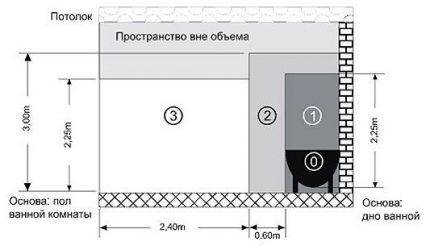
Wiring for heated towel rail performed in compliance with electrical safety standards in rooms with high humidity:
- connection via a three-wire cable with grounding;
- only concealed wiring is permissible;
- the socket must have a rubber seal and a cover covering the openings of the contacts;
- for the electric network, copper wires of grades are used VVGng and VVGng-LS.
A prerequisite for the installation and operation of electrical appliances is the use RCDdisconnecting the device when current performance is exceeded.
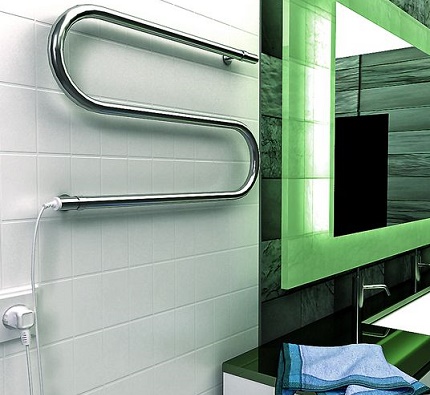
Conclusions and useful video on the topic
Recommendations for choosing towel dryers are given in the video clip:
Installation process water heated towel rail displayed in video clip:
Mounting technology heated towel rail depends on the selected model. The operability of the water device is determined by a well-designed and executed insertion scheme.
When installing the electric model, special attention is paid to operational safety. Installation of a combined “coil” is best entrusted to professionals.
Do you have personal experience installing a heated towel rail? Want to share helpful tips or ask questions about the topic? Please leave comments - the feedback form is located below.


 Transfer the heated towel rail to another wall in the bathroom: installation instructions
Transfer the heated towel rail to another wall in the bathroom: installation instructions 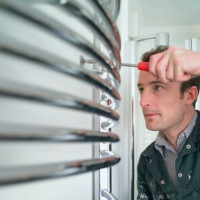 How to replace a heated towel rail in a bathroom according to the rules
How to replace a heated towel rail in a bathroom according to the rules 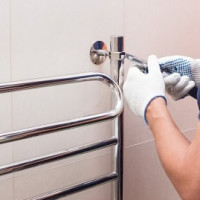 How to connect a heated towel rail to the DHW riser and a heating circuit with your own hands
How to connect a heated towel rail to the DHW riser and a heating circuit with your own hands 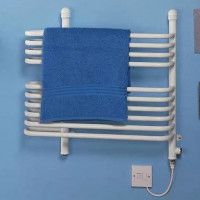 Connecting an electric heated towel rail: step-by-step installation instructions
Connecting an electric heated towel rail: step-by-step installation instructions 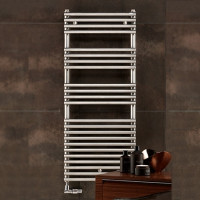 How to choose a heated towel rail for the bathroom: what to look at before buying + an overview of popular brands
How to choose a heated towel rail for the bathroom: what to look at before buying + an overview of popular brands 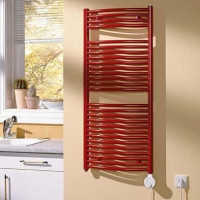 How to choose an electric heated towel rail for the bathroom: selection tips and best options
How to choose an electric heated towel rail for the bathroom: selection tips and best options  How much does it cost to connect gas to a private house: the price of organizing gas supply
How much does it cost to connect gas to a private house: the price of organizing gas supply  The best washing machines with dryer: model rating and customer tips
The best washing machines with dryer: model rating and customer tips  What is the color temperature of light and the nuances of choosing the temperature of the lamps to suit your needs
What is the color temperature of light and the nuances of choosing the temperature of the lamps to suit your needs  Replacement of a geyser in an apartment: replacement paperwork + basic norms and requirements
Replacement of a geyser in an apartment: replacement paperwork + basic norms and requirements
Accept the amendment. The RCD (residual current circuit breaker) breaks the circuit not when current performance is exceeded, but in case of current leakage (usually more than 30 mA). Those. in case an insignificant part of the current leaves the circuit (breakdown or wetting), the RCD will turn off the supply. The device that disconnects the circuit when the performance is exceeded is called an automatic machine.
In case of leaks, the machine does not work, it only works if its operating characteristic is exceeded, which is quite large and expressed in amperes (tripping during short circuit, exceeding the load current). High-quality RCD fulfills instantly, the machine when exceeding the load is triggered depending on its class (from several seconds to several minutes; with short-circuit instantly). A device that combines an RCD and an automatic machine is called a difavtomat.
We in the bath ourselves chose a place for a heated towel rail. There are no riches of options in a standard bathroom measuring 2m x 1.5m, therefore, they could be determined only with the form of drying in width and installing it in height. It seems that all the nuances noted earlier were taken into account, but all the same, sometimes I touch him with my shoulder and burn myself. The temperature of hot water in the pipes in our five-story building is always higher than the permissible, 85-89 degrees, although this is prohibited.
Hello. Tell me, please, why the radiator with water and electrics is not heated by heating? The radiator was removed several times and put back in connection with the repair. Now there is water in it, but cold. While the autonomy boiler is working. What mistake was made by amateurs? Water radiator ,, GORDIVARI ,, white with electricity.
I bought a brand new heated towel rail: excellent quality, at a low price. Only he didn’t dare to install it himself: there are too many subtleties when connected to a metal-plastic pipe. I called the plumbers, they know how to do all this competently, and I myself could not shut off the water supply to the riser in the entrance.
I have a question about installing a water heated towel rail.It so happened that the repair is almost complete, and the heated towel rail has not yet been installed. True, plumbers worked before the start. We made bends in a cabinet with taps. Now the question itself. Is it possible to connect a heated towel rail with these pins on a pipe with polypropylene pipes.
Who speaks, someone speaks in no case. I don’t feel like pouring neighbors at all! And is it possible now to install metal connections in a plumbing cabinet. Attaching photo.
And one more question. Should the distances between the inlets and outlets on the pipe on the heated towel rail match?
Good afternoon! The idea came up to install a heated towel rail in the kitchen. We have an apartment building (7 floors). Can I install a heated towel rail in the kitchen? If you need permission, tell me where to go. I did not find information on this issue. Thank!
Hello. In general, even the replacement of an old heated towel rail with a new one in the bathroom of an apartment building should be approved by the relevant organizations. Permission, of course, is necessary, moreover, you will have to legitimize the reorganization of engineering systems. You need to contact the Criminal Code, Homeowners Association, in general, the organization that manages your home. Moreover, doing such work yourself without the involvement of specialists is not worth it.
Now, regarding your question: do you want to move the heated towel rail from the bathroom to the kitchen or mount a new one? In any case, you need to coordinate the project in the UK, which serves your home. If you need a transfer, then you need stubs at the old location of the substation. An insert to a new place in the kitchen will be needed anyway. I advise you to do everything officially and with the assistance of specialists, so as not to disrupt the normal functioning of the home heating system.
But it will be much easier to install an electric substation in the kitchen: you do not need any permissions, involve specialists in the installation, you can do everything yourself.